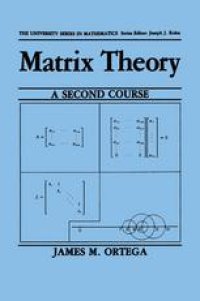
Ebook: Matrix Theory: A Second Course
Author: James M. Ortega (auth.)
- Tags: Algebra
- Series: The University Series in Mathematics
- Year: 1987
- Publisher: Springer US
- Edition: 1
- Language: English
- pdf
Linear algebra and matrix theory are essentially synonymous terms for an area of mathematics that has become one of the most useful and pervasive tools in a wide range of disciplines. It is also a subject of great mathematical beauty. In consequence of both of these facts, linear algebra has increasingly been brought into lower levels of the curriculum, either in conjunction with the calculus or separate from it but at the same level. A large and still growing number of textbooks has been written to satisfy this need, aimed at students at the junior, sophomore, or even freshman levels. Thus, most students now obtaining a bachelor's degree in the sciences or engineering have had some exposure to linear algebra. But rarely, even when solid courses are taken at the junior or senior levels, do these students have an adequate working knowledge of the subject to be useful in graduate work or in research and development activities in government and industry. In particular, most elementary courses stop at the point of canonical forms, so that while the student may have "seen" the Jordan and other canonical forms, there is usually little appreciation of their usefulness. And there is almost never time in the elementary courses to deal with more specialized topics like nonnegative matrices, inertia theorems, and so on. In consequence, many graduate courses in mathematics, applied mathe matics, or applications develop certain parts of matrix theory as needed.